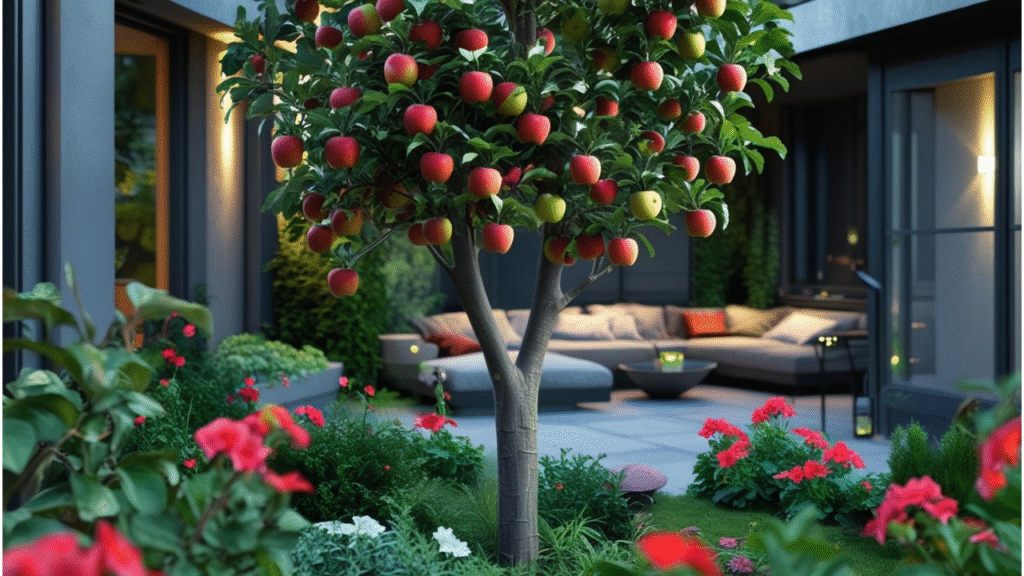
How to Grow Columnar Apple Trees: A Complete Guide for Small Spaces and Maximum Fruit Yield
Are you dreaming of fresh, homegrown apples but struggling with limited garden space? 🍏 You’re not alone! Many gardeners are discovering the incredible benefits of columnar apple trees, a compact solution that allows you to grow apples in even the smallest spaces. Whether you have a small backyard, a balcony, or just a cozy patio, these vertical-growing trees can bring the orchard right to your doorstep—without taking up too much room.
Columnar apple trees are not only space-saving but also highly productive, making them the perfect choice for urban gardeners or anyone looking to maximize their garden’s potential. But how do you care for these unique trees and get the best yield possible? This guide will walk you through everything you need to know, from planting to harvesting, ensuring that even beginners can successfully grow these fruitful beauties. Ready to transform your space and enjoy your own apples? Keep reading! 🌳🍏
Table of Contents
Toggle🌳✨ What Are Columnar Apple Trees? 🍏🌱
If you’re new to gardening 🌱 or just looking for a space-saving way to grow your own apples 🍏, columnar apple trees 🌳 might just be the perfect solution! These unique trees have a narrow, upright shape 🏙️, allowing them to thrive in small spaces like urban gardens 🏡, patios 🪴, or even balconies 🌇.
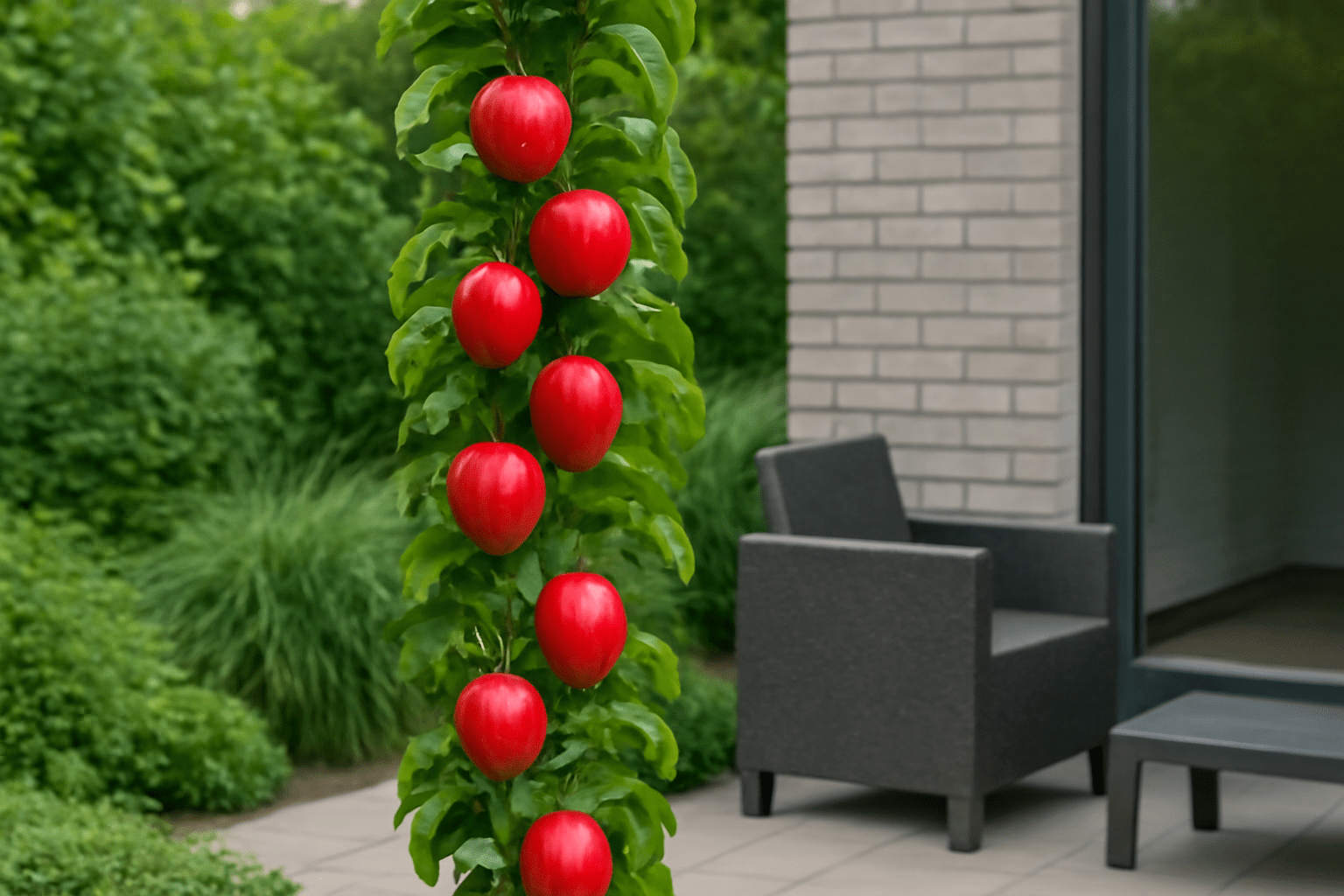
🍏 What Makes Columnar Apple Trees Different? 🍏
Unlike traditional apple trees 🌳 that spread out horizontally, columnar apple trees grow tall 🌱 and slim—reaching heights of 6-8 feet 🌳 and only about 18-24 inches wide 🌿. This makes them ideal for gardeners 👩🌾 who want to maximize limited space without sacrificing fruit production 🍏.
🌳 Popular Varieties of Columnar Apple Trees 🌳
There are several types of columnar apple trees 🌳 to choose from, each with its own unique features ✨. Some of the most popular include:
- Bolero: Known for its high yield and compact growth 🌱.
- Scarlet Sentinel: Beautiful red apples 🍎 with a sweet, tart flavor 🍏.
- North Pole: Cold-hardy ❄️ and great for colder climates 🌨️.
These varieties not only save space 🏡 but also offer different apple flavors 🍏, sizes 🍎, and textures 🍽️ to suit your preferences 😋.
🌿 Why Are Columnar Apple Trees So Special? 🌿
- Compact Growth: Their vertical structure 🌳 allows them to fit into tight spaces 🏙️ while still producing abundant fruit 🍏.
- High Yield: Despite their size 🌱, columnar apple trees can bear as much fruit 🍎 as larger varieties 🌳, often in just a few years ⏳.
- Low Maintenance: With proper care 🌱, these trees require less pruning ✂️ and can even thrive in containers 🪴!
Whether you’re growing them for the aesthetic appeal 🌟 or the delicious fruit 🍏, columnar apple trees offer a wonderful, practical solution for gardeners with limited space 🏙️.
Columnar apple trees 🌳 are a game-changer for small-space gardeners 🌱. Their compact nature 🍏, paired with high yields 🍎, makes them perfect for anyone looking to grow fresh apples 🍏 without a sprawling backyard 🌿. Ready to learn how to plant 🌱 and care for them? Keep reading! 📚
🌿🍏 Why Choose Columnar Apple Trees for Small Spaces? 🍏🌿
If you’re limited on space 🏙️ but still want the joy of growing your own apples 🍏, columnar apple trees 🌳 are the perfect solution. These compact, vertical-growing trees 🌱 are ideal for small gardens 🏡, patios 🪴, balconies 🏢, or even urban spaces 🌇 where traditional apple trees 🌳 would be too large. Here’s why they’re a great choice for small spaces 🌿:
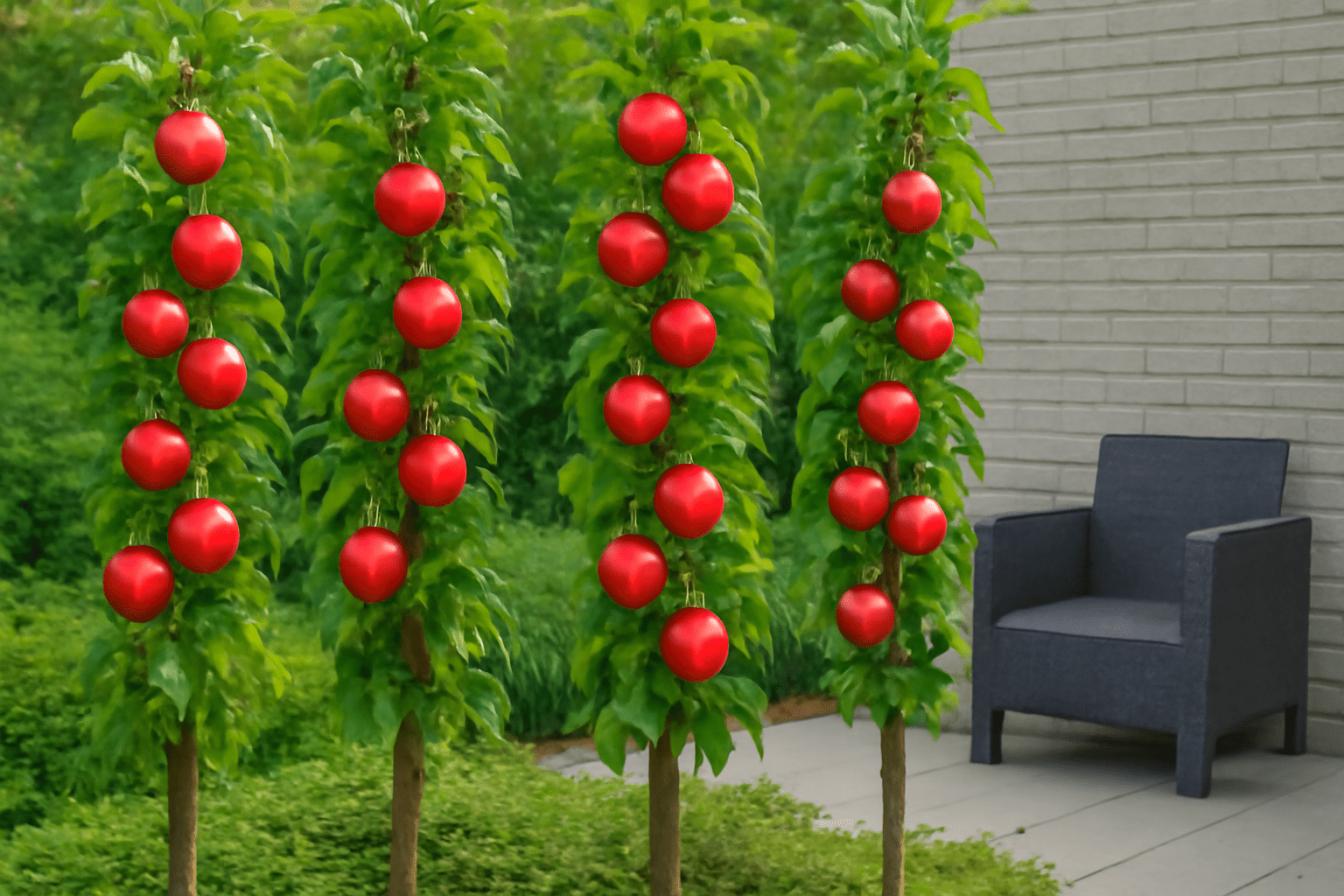
🏡 Space Efficiency: Maximize Your Small Garden Area 🏡
Columnar apple trees 🌳 take up very little horizontal space 🌱. Their upright, narrow shape 🌳 allows them to thrive in tight spots without overwhelming your garden 🌸. You can easily plant several columnar trees 🌳 side by side, maximizing the use of small spaces like balconies 🏙️, courtyards 🌿, or even narrow garden beds 🪴.
🍏 Easy Harvesting: Accessible and Convenient 🍏
Thanks to their compact size 🍏, columnar apple trees 🌳 make harvesting simple and efficient 🏡. No need for ladders 🪜 or reaching through thick branches 🌿—everything is within arm’s reach 🙌! This means you can harvest your apples 🍏 with ease, even if you’re a beginner 🌱 or have limited mobility ♿.
🌸 Aesthetic Appeal: A Beautiful Addition to Your Garden 🌸
Columnar apple trees 🌳 aren’t just practical—they’re also visually appealing 🌷. Their tall, elegant shape adds structure 🌱 and sophistication to any garden 🏡 or outdoor space 🌳. With their stunning blossoms 🌸 in the spring 🌷 and vibrant fruits 🍏 in the summer ☀️, these trees 🌳 become a focal point that enhances the beauty of your garden year-round 🌿.
🍎 High Yield in Small Areas: Get More Fruit from Less Space 🍎
One of the best features 🌟 of columnar apple trees 🌳 is their impressive yield 🍏. Despite their compact size 🌱, these trees 🌳 produce a surprising amount of fruit 🍏, meaning you can enjoy homegrown apples 🍏 even in small spaces 🏙️. With the right care 🌱, you’ll get a healthy 💚, bountiful harvest 🍎 each season 🌱.
Columnar apple trees 🌳 offer a perfect solution for small-space gardening 🌱. With their efficient use of space 🏡, easy-to-reach fruit 🍏, aesthetic beauty 🌸, and high yield 🍎, they are a fantastic way to enjoy fresh, homegrown apples 🍏 without needing a large garden 🏡. Ready to learn how to grow these space-saving trees 🌳? Keep reading 📚!
🌿🍏 How to Plant Columnar Apple Trees 🍏🌿
Planting columnar apple trees 🌳 is a straightforward process, but getting it right from the start is essential for ensuring strong 💪, healthy growth 🌱. Follow this step-by-step guide 📝 to make sure your tree 🌳 gets the best start possible in your small space 🏡!
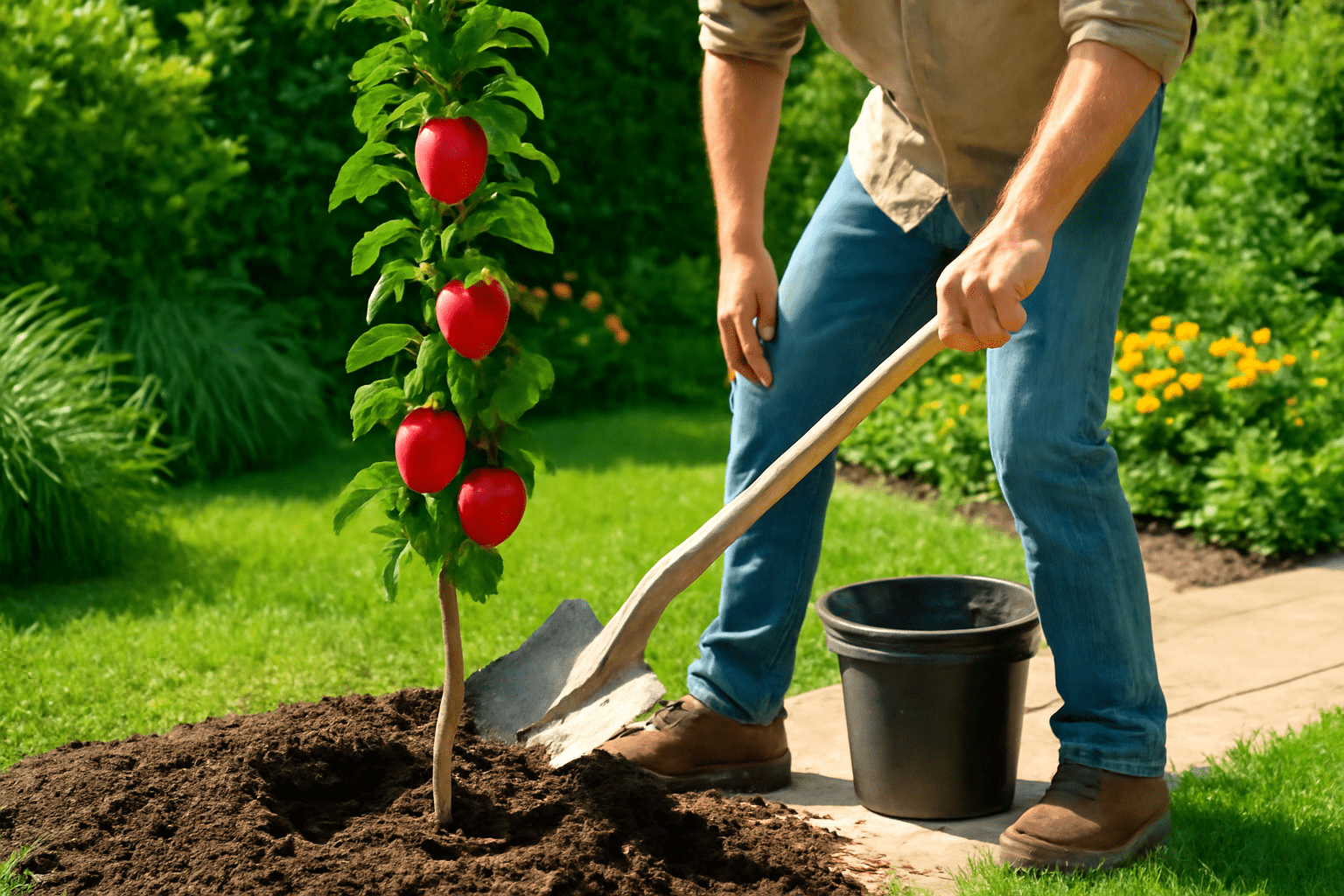
🌞 Choosing the Right Spot 🌞
Before you begin 🌱, it’s crucial to choose the right location 📍 for your columnar apple tree 🌳. Here’s what to look for:
- Full Sun: Ensure your tree 🌳 will get 6-8 hours of direct sunlight each day 🌞. Sunlight is key for good fruit 🍏 production.
- Well-Draining Soil: Choose a spot with soil 🌍 that drains well 💧. Standing water can lead to root rot 🦠, so make sure the area isn’t prone to pooling water 💦.
- Space for Vertical Growth: Columnar apple trees 🌳 grow tall 🌱 but narrow, so make sure there’s enough space for the tree 🌳 to grow upward without obstruction 🚧 (e.g., nearby buildings 🏢 or structures 🏠).
🌱 Best Planting Time 🌱
The ideal time ⏳ to plant columnar apple trees 🌳 is during the fall 🍂 or early spring 🌸. During these seasons, the tree 🌳 has time to establish its roots 🦶 before the extreme heat 🔥 or cold ❄️ sets in. Fall planting allows the tree 🌳 to grow roots over the winter ❄️, while spring planting ensures strong growth 🌱 as temperatures warm up 🌞.
🏡 Soil Preparation 🏡
Healthy soil 🌍 is vital for the success of your columnar apple tree 🌳. Here’s how to get your soil ready:
- Add Compost: Improve the soil 🌱 by mixing in compost or organic matter 🌿 to enrich it with nutrients 💚. This helps with drainage 🌬️ and provides essential minerals for your tree 🌳.
- Check Soil pH: Apple trees 🌳 prefer slightly acidic soil 🌿 with a pH of 6-7. If needed, amend the soil 🌍 with lime 🪴 to raise the pH or sulfur 🌱 to lower it.
🕳 How to Plant Columnar Apple Trees 🕳
- Dig the Right-Sized Hole: Dig a hole 🕳 that’s about twice the width and the same depth as the tree’s root ball 🌳. This ensures the roots 🦶 have room to spread and establish themselves.
- Place the Tree at the Right Depth: Gently remove the tree 🌳 from its container 🪴 and place it in the hole 🕳. The top of the root ball 🦶 should be level with the surrounding soil 🌍. Planting too deep can suffocate the roots 🦶.
- Fill the Hole: Backfill the hole 🕳 with soil 🌿, making sure the tree 🌳 is centered and upright. Lightly pack the soil 🌱 around the base to eliminate air pockets 🌬️.
- Water After Planting: Once the tree 🌳 is in place, water 💧 thoroughly to help settle the soil 🌍 and establish good contact with the roots 🦶. Watering 💦 also helps the tree 🌳 recover from any transplant shock.
🌳 Spacing Requirements 🌳
To ensure optimal growth 🌱, space your columnar apple trees 🌳 about 18-24 inches apart 🏡. Their narrow profile 🌱 means they can grow close to each other, but leaving this space 🌬️ will give them enough room for healthy root development 🦶 and airflow 🌿.
Quick Reference Checklist: 📋
- 🌞 Sunlight: Ensure 6-8 hours of direct sunlight daily 🌞.
- 🌱 Soil: Choose well-draining, fertile soil 🌿 with a pH of 6-7.
- 🌳 Spacing: Space trees 🌳 18-24 inches apart 🏡.
- 🏡 Planting Depth: Keep the root ball 🌳 level with the surrounding soil 🌍.
- 💧 Water: Water 💦 deeply after planting 🌳 to settle the soil 🌍.
By following these simple steps 📝, you’ll ensure that your columnar apple tree 🌳 gets the best possible start 🌱. In no time, you’ll be on your way to enjoying fresh 🍏, homegrown apples in your small space 🏡! Ready to care for your new tree 🌳? Let’s move on to the next step! 🌿
🌿🍏 Caring for Columnar Apple Trees 🍏🌿
Proper care 🌱 is essential for keeping your columnar apple trees 🌳 healthy and productive 🍏. With the right attention 👩🌾, you can maximize fruit yield 🍏 and ensure your tree 🌳 thrives for years to come 🌱. Here are some essential care tips 🌟 that will help you achieve just that.
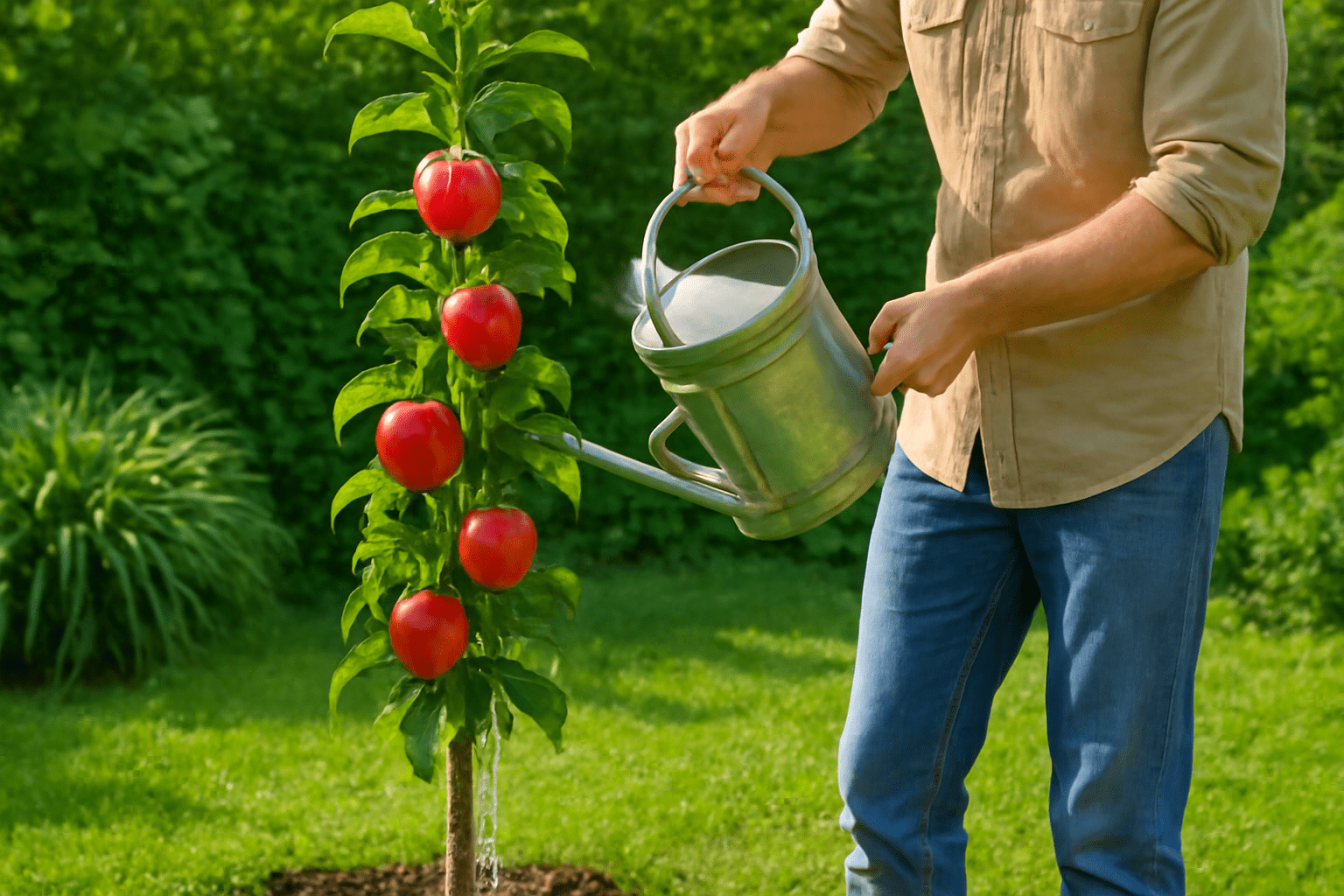
💧 Watering Needs: Deep Watering, Avoiding Waterlogging 💧
Watering 💦 is one of the most important aspects of tree care 🌳. Columnar apple trees 🌳 need a consistent supply of water 💧 to support healthy growth 🌱, especially during the growing season 🌞.
- Deep Watering: Water 💧 your tree 🌳 deeply rather than shallowly. This encourages the roots 🦶 to grow deeper into the soil 🌍, which helps the tree 🌳 become more drought-resistant in the future 💦.
- Avoid Waterlogging: Make sure the soil 🌍 drains well and doesn’t hold water around the roots 🦶. Overwatering 💧 or poor drainage 🌍 can lead to root rot 🦠, which can harm or kill your tree 🌳. Always check the soil 🌱 before watering 💧 to ensure it’s not too wet 🌊.
🌱 Fertilizing: Best Fertilizers for Columnar Apple Trees 🌱
Healthy 🌿, well-fed trees 🌳 are more likely to produce high-quality fruit 🍏. Columnar apple trees 🌳 benefit from regular feeding 🍽️, especially during the growing season 🌞.
- Best Fertilizers: Use a balanced, slow-release fertilizer 🌱 that’s rich in nitrogen 🌿, phosphorus 🌱, and potassium 🧪. Organic options like compost 🌿, well-rotted manure 🐄, or an organic fruit tree fertilizer 🍏 are great choices 🌱.
- When and How to Apply: Apply fertilizer 🌿 in early spring 🌸 as the tree 🌳 begins to grow 🌱 and again in late summer 🍂 to support fruit development 🍏. Follow the instructions 📋 on the product for proper application rates, as over-fertilizing 🌱 can harm the tree 🌳.
✂️ Pruning and Shaping: Keep Your Tree Healthy and Beautiful ✂️
Regular pruning ✂️ is essential for maintaining the shape 🌳 of your columnar apple tree 🌳 and encouraging healthy growth 🌱.
- Pruning for Shape: Remove any dead, diseased, or damaged branches 🌿 to keep the tree 🌳 looking neat and encourage strong growth 🌱. Pruning ✂️ helps improve airflow 🌬️ and sunlight penetration 🌞, which are crucial for fruit production 🍏.
- Shaping the Tree: Since columnar apple trees 🌳 naturally grow in a vertical shape 🌱, it’s important to maintain this form by trimming ✂️ any sideways or outward-growing branches 🌿. This keeps the tree 🌳 compact and maximizes its fruit production 🍏.
🐛 Pest and Disease Control: Keep Your Tree Safe from Harm 🐛
Columnar apple trees 🌳 are generally hardy 💪, but they can still be affected by pests 🐛 and diseases 🦠. Regularly check 👀 your tree 🌳 for signs of trouble and take action early ⚠️.
- Common Pests: Aphids 🐞, apple maggots 🦠, and spider mites 🕷️ can be problematic. Look for signs such as curled leaves 🍃, discolored fruit 🍏, or sticky residue 🦠 on the tree 🌳.
- Organic Treatments: Treat pests 🐛 with organic solutions like neem oil 🌿, insecticidal soap 🧴, or diatomaceous earth 🏵️. These are safe for both the tree 🌳 and the environment 🌍. Always follow the instructions 📋 on the label for the best results 🌱.
- Disease Prevention: Keep your tree 🌳’s leaves 🍃 clean and avoid overhead watering 💧, which can promote fungal growth 🦠. Regularly remove fallen leaves 🍂 and fruit 🍏 from around the base to prevent diseases like apple scab 🍏 or powdery mildew 🌱.
By following these care tips 🌱, you’ll give your columnar apple tree 🌳 the best chance for healthy growth 🌿 and maximum fruit yield 🍏. Whether you’re a first-time grower 🌱 or an experienced gardener 👩🌾, these simple steps will ensure your tree 🌳 stays strong 💪, productive 🍏, and beautiful 🌿! 🌳🍏
🌿🍏 Pollination and Fruit Production 🍏🌿
Pollination 🌸 is a key factor in ensuring your columnar apple trees 🌳 produce a healthy 🍏 and abundant crop of fruit 🍏. In this section, we’ll guide you through the pollination process 🌱, highlight self-pollinating varieties 🍏, and provide tips for successful fruit production 🍏.
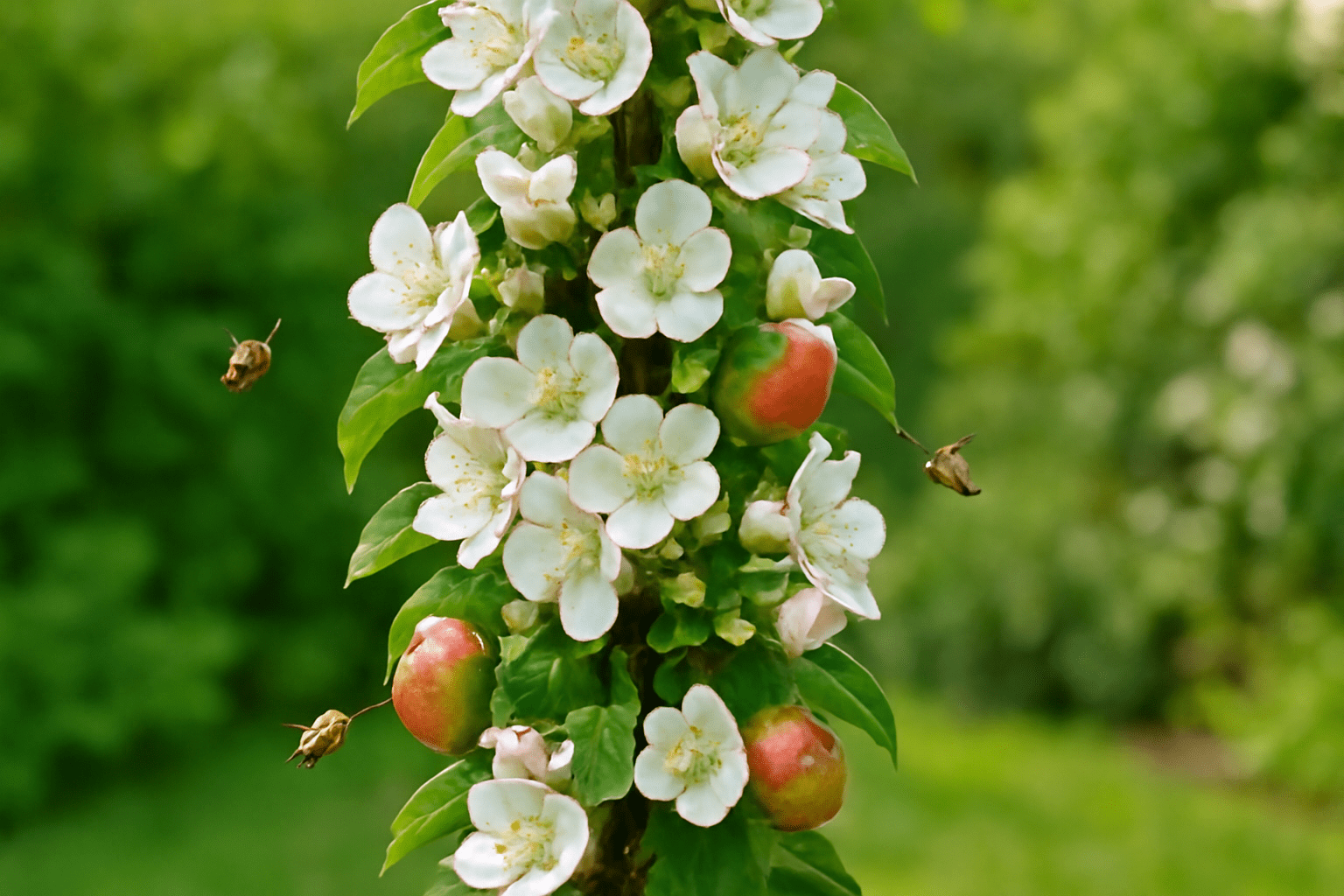
🌸 Cross-Pollination: Boosting Fruit Production with Multiple Varieties 🌸
For the best fruit 🍏 production, cross-pollination 🌸 is often necessary. While some columnar apple trees 🌳 can produce fruit 🍏 on their own, having multiple varieties nearby 🌱 can significantly improve the quality 🏆 and quantity 🍏 of your harvest 🍏. Cross-pollination occurs when pollen from one tree 🌳 is transferred to the flowers 🌸 of another, typically by bees 🐝 or wind 🌬️.
- Why Cross-Pollination Matters: Having two or more apple trees 🌳 of different varieties helps ensure that pollen from one tree 🌳 reaches the flowers 🌸 of the other. This leads to better fruit set 🍏 and increases the tree’s overall yield 🌱.
- Best Results: Ideally, choose varieties 🍏 that bloom around the same time 🕰️ to maximize the chances of successful pollination 🌸.
🍏 Self-Pollinating Varieties: Do Some Columnar Apple Trees Pollinate Themselves? 🍏
Yes! Some columnar apple trees 🌳 are self-pollinating 🌸, meaning they do not require another tree 🌳 for pollination. These trees 🌳 can produce fruit 🍏 on their own, making them ideal for gardens 🏡 with limited space or where planting multiple trees 🌳 isn’t possible. However, even self-pollinating trees 🌳 often produce better fruit yields 🍏 with cross-pollination 🌸.
- Self-Pollinating Varieties: Popular self-pollinating columnar apple tree 🌳 varieties include:
- ‘North Pole’ 🌱: Known for its cold hardiness ❄️ and compact growth 🌳.
- ‘Golden Sentinel’ 🍏: A great option for both taste and self-pollination 🌱.
Though these trees 🌳 can produce fruit 🍏 on their own, adding another variety nearby 🌱 still helps maximize yield 🍏 and fruit quality 🍏.
🌳 Pollination Partners: Companion Trees for Optimal Pollination 🌳
If you want to take full advantage of cross-pollination 🌸, it’s important to plant compatible companion trees 🌳. When choosing pollination partners 🌱, make sure they are from the same apple species 🍏 and bloom around the same time ⏰.
- Recommended Companion Trees:
- ‘Jonny Gold’ 🍏 pairs well with most columnar varieties 🌳 for successful cross-pollination 🌸.
- ‘Braeburn’ 🍎 is another great option to pollinate columnar apples 🍏, ensuring a high fruit set 🍏.
Ensure that your chosen pollination partners 🌳 are within 100 feet of your columnar apple trees 🌳 to maximize the chances of successful pollen transfer 🐝.
🍎 Signs of Healthy Fruit Set: How to Know Your Tree is Producing Fruit 🍎
After successful pollination 🌸, you’ll start to see signs 👀 that your columnar apple tree 🌳 is ready to produce fruit 🍏. Keep an eye out 👀 for these indicators:
- Flowering 🌸: During the spring 🌷, your tree 🌳 will bloom with beautiful apple blossoms 🌸. If you see a lot of flowers 🌸, it’s a good sign that pollination 🌸 is likely successful.
- Tiny Apples 🍏: Once the flowers 🌸 have been pollinated, you’ll start to see small fruit 🍏 beginning to form. Healthy fruit development 🍏 begins with the gradual swelling of these tiny apples 🍏.
- Fruit Growth 🍏: As summer progresses 🌞, the fruit 🍏 will begin to grow 🌱, and the tree 🌳 will start to look fuller. The apples 🍏 should gradually increase in size 🌱, and their color will begin to change 🌈 as they ripen.
If you notice fewer flowers 🌸 or a lack of fruit 🍏 set, it might be time to check your pollination setup 🌿 and ensure that your trees 🌳 are getting enough cross-pollination 🌸 from compatible varieties 🌳.
By understanding the importance of pollination 🌸 and choosing the right companion trees 🌳, you’ll ensure that your columnar apple trees 🌳 produce a bountiful harvest 🍏. Whether you’re growing self-pollinating varieties 🌱 or optimizing with cross-pollination 🌸, you’re on your way to enjoying delicious 🍏, homegrown apples! 🍏🌳
🌿🍏 Troubleshooting Common Issues with Columnar Apple Trees 🍏🌿
Even the hardiest columnar apple trees 🌳 can encounter issues from time to time. If you notice your tree 🌳 isn’t thriving as expected, don’t worry! In this section, we’ll cover common problems 🐛 you might face and provide practical solutions 🔧 to help your tree 🌳 bounce back stronger than ever 💪.
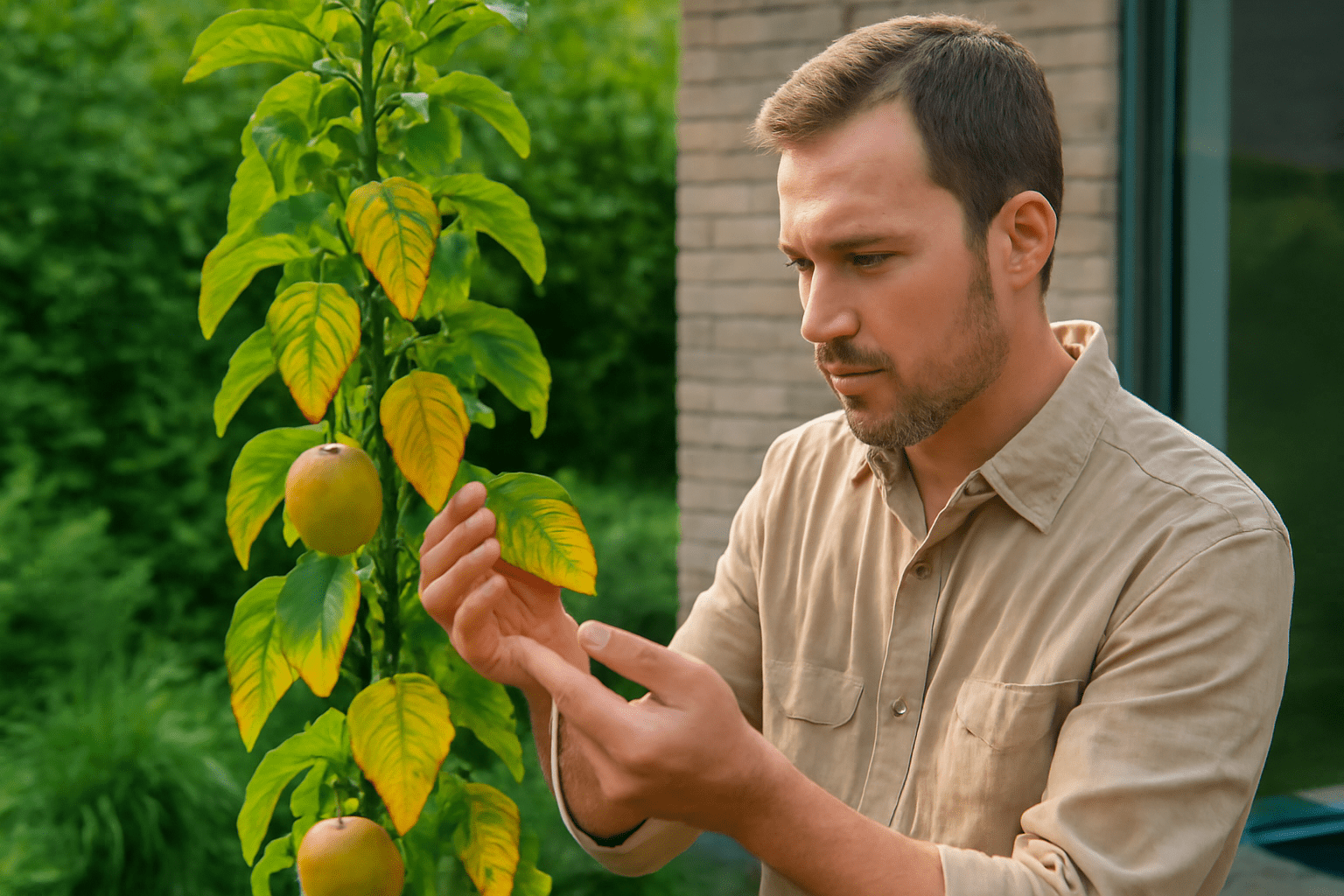
🍂 Yellowing Leaves: What’s Going Wrong? 🍂
Yellowing leaves 🍃 are one of the most common issues gardeners 👩🌾 face with apple trees 🌳. This can be caused by a few different factors ⚠️, so it’s important to diagnose the problem correctly 🧐.
- Nutrient Deficiencies: One of the most common reasons for yellow leaves 🍃 is a lack of key nutrients 💚, particularly nitrogen 🧪. Nitrogen is essential for healthy leaf growth 🍃, and if the soil 🌍 is lacking, the leaves 🍃 may turn yellow 🍏.
- Solution: Add a balanced fertilizer 🌿 high in nitrogen or apply compost 🌱 to improve soil fertility 🧑🌾.
- Overwatering: Another cause of yellowing leaves 🍃 can be overwatering 💧, which leads to root rot 🦠 and poor oxygenation 🌱.
- Solution: Ensure the soil 🌍 is well-draining and allow it to dry out between waterings 💧. Make sure to water deeply 💦 but infrequently to avoid waterlogging 🏞️.
- Poor Drainage: If water 💧 isn’t draining properly, the roots 🦶 can suffocate, leading to yellowing leaves 🍃 and overall poor health 🌱.
- Solution: If you suspect poor drainage 🌍, try amending the soil 🌿 with organic matter 🪴 or consider planting the tree 🌳 in a raised bed 🏡 or container 🪴.
🍏 Poor Fruit Yield: Why Aren’t You Getting Apples? 🍏
If your columnar apple tree 🌳 isn’t producing as much fruit 🍏 as expected, there could be several reasons. Let’s take a look at the most common causes ⚠️:
- Lack of Pollination 🌸: Columnar apple trees 🌳, while often self-pollinating, can benefit from additional cross-pollination 🌿. If you don’t have another tree 🌳 of a compatible variety nearby, fruit set 🍏 may be low.
- Solution: Plant a compatible apple tree 🌳 nearby to encourage cross-pollination 🌸. Ensure that both trees 🌳 bloom around the same time ⏰ for the best results 🌿.
- Improper Care 🌱: Inconsistent watering 💧, poor soil 🌍, or lack of nutrients 🌱 can prevent a tree 🌳 from producing fruit 🍏.
- Solution: Make sure your tree 🌳 is getting enough sunlight 🌞, water 💧, and nutrients 🍏. Regularly check the soil pH 🌿 and adjust it if necessary 🔧.
- Tree Stress 🌿: Factors like extreme weather conditions 🌨️, root damage 🦶, or overcrowding 🌱 can cause stress 😓, which reduces fruit production 🍏.
- Solution: Protect your tree 🌳 from strong winds 🌬️, frost ❄️, or excessive heat ☀️. Ensure it has enough space 🌿 to grow and isn’t competing for resources with other plants 🪴.
🐞 Diseases and Pests: How to Identify and Manage Problems 🐞
Pests 🐛 and diseases 🦠 can be a significant threat to the health of your columnar apple tree 🌳. Being proactive 🕵️♂️ is key to keeping your tree 🌳 healthy and protected 💪.
- Aphids 🐜: These tiny insects 🐛 can weaken the tree 🌳 by sucking sap 🍃 from the leaves 🍃, leading to yellowing 🍏 and stunted growth 🌱. You may also notice sticky residue 💧 on the leaves 🍃.
- Solution: Use an organic insecticidal soap 🧴 or neem oil 🌿 to treat aphids 🐜. You can also hose 🚿 them off with a strong spray of water 💧 to get rid of them 🐜.
- Apple Maggots 🐛: These pests 🦠 lay eggs 🥚 in the fruit 🍏, and their larvae 🐛 can cause the apples 🍏 to rot 🍎.
- Solution: Place yellow sticky traps 🟨 around your tree 🌳 to attract and capture adult apple maggots 🐛. If you spot affected fruit 🍏, remove and dispose of it immediately 🚮.
- Apple Scab 🍏: A common fungal disease 🦠 that causes dark, scabby lesions on leaves 🍃 and fruit 🍏, leading to poor tree health 🌱.
- Solution: Remove fallen leaves 🍂 and fruit 🍏, as these can harbor spores 🦠. Consider using a fungicide 🧴 or applying organic treatments like sulfur 🌱 to prevent the spread of apple scab 🍏.
- Other Common Diseases 🦠: Powdery mildew ❄️, fire blight 🔥, and root rot 🦠 are other potential threats to columnar apple trees 🌳.
- Solution: Practice good sanitation 🌿 by removing any infected plant material 🌱. Ensure the tree 🌳 is planted in well-drained soil 🌍 to prevent root rot 🦠 and other soil-borne diseases 🌱.
By identifying the cause 🧐 of any problems and taking quick action ⚡, you can prevent many common issues with your columnar apple trees 🌳. Whether it’s improving watering 💧 habits, ensuring proper pollination 🌸, or managing pests 🐛, these tips will help keep your tree 🌳 healthy 💚 and productive 🍏. Ready to enjoy a bountiful harvest 🍏? Keep up with regular care 🧑🌾, and your tree 🌳 will reward you! 🌳🍏
🌿🍏 Harvesting and Enjoying Your Columnar Apple Trees 🍏🌿
One of the most rewarding aspects of growing columnar apple trees 🌳 is, of course, harvesting your homegrown apples 🍏. Whether you plan to snack on them fresh 🍏, bake them into pies 🥧, or turn them into juice 🍹, here’s everything you need to know to harvest 🍏 and enjoy your apples 🍏 to the fullest.
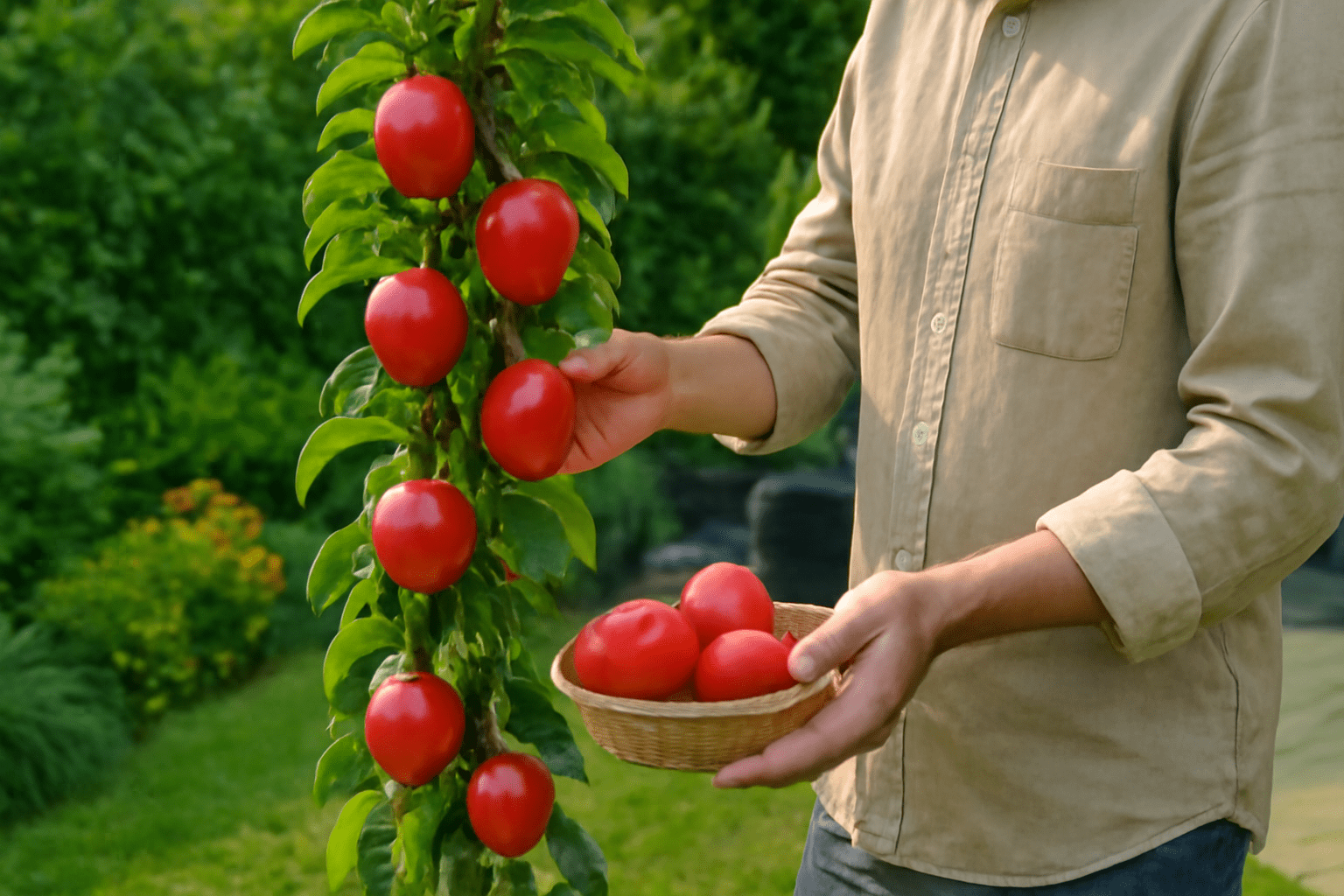
🍎 When to Harvest: Signs Your Apples Are Ready 🍎
Knowing when to pick your apples 🍏 is key to ensuring they’re at their peak flavor 🌞. Here’s what to look for:
- Color Change 🌞: As apples 🍏 ripen, they begin to change color 🌈. Look for a rich, uniform color 🌟 that corresponds to the variety of apple 🍏 you’re growing. For example, Red Delicious 🍏 apples will turn a deep red, while Golden Sentinel 🍏 will have a yellow hue.
- Ease of Detachment 🍏: A ripe apple 🍏 should come off the tree 🌳 easily. Gently tug on the apple 🍏, and if it detaches with little resistance, it’s ready for harvest 🍏.
- Texture 👌: Apples 🍏 should feel firm to the touch, but not rock-hard 🪨. If they yield slightly to gentle pressure, they’re at the perfect ripeness 🍏 for picking 🍏.
🧺 How to Harvest: Tips for Picking Apples Without Damaging the Tree 🧺
Harvesting apples 🍏 properly ensures that your tree 🌳 remains healthy and productive 🍏 for years to come 🌱. Follow these simple steps 📝 to ensure a gentle, damage-free harvest 🍏:
- Use Both Hands 🤲: When picking apples 🍏, use both hands 🤲 to avoid unnecessary strain on the tree 🌳. Support the apple 🍏 with one hand 🤲 and twist gently with the other to loosen it from the branch 🌳.
- Gently Twist 🍏: Instead of pulling or jerking 💪, twist the apple 🍏 lightly to separate it from the stem 🌿. This minimizes damage to the tree 🌳 and prevents breaking branches 🌿.
- Avoid Damaging the Tree 🌳: Be mindful of the tree 🌳’s delicate branches 🍃. Avoid shaking or tugging on the tree 🌳, as this can cause stress 😓 and reduce future fruit production 🍏.
🍏 Storing Apples: How to Keep Them Fresh for Longer 🍏
Once you’ve harvested your apples 🍏, it’s important to store them properly 🏡 to maintain their freshness 🧊:
- Cool and Dry Storage 🏡: Store apples 🍏 in a cool, dry place 🌬️, such as a cellar 🏠 or a cool kitchen counter 🍏. Avoid placing them in direct sunlight ☀️ or anywhere warm 🌞.
- Refrigeration for Long-Term Storage ❄️: If you want to store apples 🍏 for a longer period, place them in the fridge 🧊. A crisper drawer 🍏 is ideal, as it maintains the right level of humidity 🌱.
- Check Regularly 🍏: Apples 🍏 can last several weeks if stored properly 🏡, but make sure to check them occasionally 👀 for any that may begin to spoil 💀. Remove damaged apples 🍏 to prevent the spread of rot 🍏.
🍴 Uses for Apples: Delicious Ways to Enjoy Your Harvest 🍴
Now that your apples 🍏 are harvested and stored 🏡, it’s time to enjoy them 🎉! Here are some creative and tasty ideas 🍏 for using your fresh apples 🍏:
- Baking 🥧: Apples 🍏 are perfect for pies 🥧, crisps 🍏, tarts 🍏, and cakes 🎂. Try baking a classic apple pie 🥧 or apple crumble 🍏 for a warm, comforting treat 🌟.
- Juicing 🍹: Fresh apple juice 🍏 is a refreshing and healthy drink 🍹. Use a juicer 🍏 to extract the juice 🍏, or blend the apples 🍏 for a delicious smoothie 🍹.
- Snacking 🍏: Enjoy apples 🍏 raw for a nutritious, crunchy snack 🍏. Pair them with cheese 🧀 or peanut butter 🥜 for an extra treat 🍏.
- Preserves and Canning 🍯: Make your own homemade apple jam 🍏, jelly 🍯, or applesauce 🍏 to enjoy throughout the year 🌱.
📌 Quick Harvesting Tips 📌
- Apples 🍏 are typically ready when they begin to color 🌈 and easily detach from the tree 🌳.
- Gently twist 🍏 the apple off to avoid damaging the tree 🌳.
Harvesting 🍏 and enjoying your columnar apple trees 🌳 is a fun and rewarding experience 🌱. Whether you’re snacking 🍏 on fresh apples, baking 🍏 them into your favorite recipes 🍏, or storing them for later 📦, there are endless ways to make the most of your homegrown fruit 🍏. 🍏🌳 Ready to dive into your first harvest 🍏? Happy picking! 🍏🌳
🌿🍏 Final Thoughts 🍏🌿
Growing columnar apple trees 🌳 in small spaces 🏡 is a rewarding experience that allows you to enjoy fresh, homegrown apples 🍏 even if you don’t have a large garden 🌱. With their compact size 🌿, high yield 🍏, and easy maintenance 🌱, these trees 🌳 offer a perfect solution for urban gardeners 🌇 or anyone looking to maximize their space 🏡.
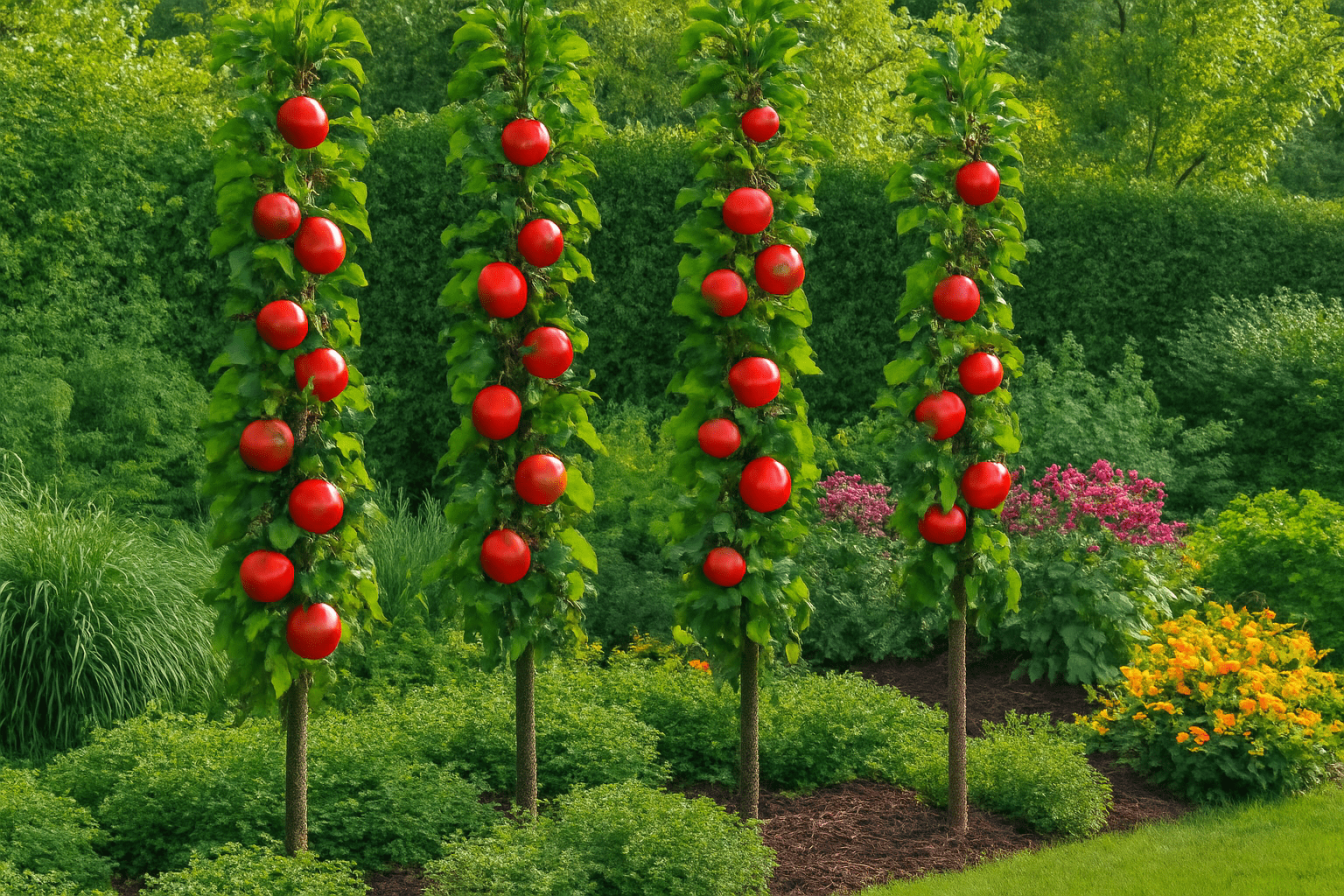
By following the steps outlined 📝 in this guide— from choosing the right spot 📍 to harvesting 🍏 and storing your apples 🍏—you can ensure your columnar apple tree 🌳 thrives and produces delicious fruit 🍏 year after year 🌱. Whether you’re new to gardening 🌱 or an experienced grower 👩🌾, columnar apple trees 🌳 provide the opportunity to enjoy the beauty of nature 🌿 and the sweetness of fresh apples 🍏 right at your doorstep 🏡. 🌏✨
Now that you have the knowledge 📚 and tips 🌱, it’s time to get started! Plant 🌱, care for 🌳, and harvest 🍏 your own columnar apple trees 🌳, and soon you’ll be reaping the fruits of your labor 🍏. Happy gardening 👩🌾! 🌳🍏
Frequently Asked Questions (FAQ)
What are columnar apple trees?
Columnar apple trees are compact apple trees that grow upright and narrow, taking up very little horizontal space. They are ideal for small gardens, patios, and urban spaces, producing high yields of fruit without spreading out like traditional apple trees. 🌱
How much space do columnar apple trees need?
Columnar apple trees need only about 18-24 inches of space in width but can grow up to 6-8 feet tall. They are perfect for small spaces like narrow garden beds or even containers. Make sure to plant them where they can grow vertically without obstruction. 🌳
Do columnar apple trees need another tree to pollinate?
Some columnar apple trees are self-pollinating, meaning they can produce fruit on their own. However, planting a second tree nearby can improve pollination and increase the fruit yield, especially if the varieties bloom around the same time. 🍏
When is the best time to plant columnar apple trees?
The best time to plant columnar apple trees is in early spring or fall. These seasons provide the ideal conditions for root establishment before the summer heat or winter cold sets in, giving your tree the best start. 🌸
How do I care for my columnar apple tree?
Caring for a columnar apple tree involves regular deep watering, providing full sunlight (6-8 hours daily), and using balanced fertilizers. Pruning is also essential to maintain its vertical shape and remove any damaged or dead branches. 🌿
How can I increase the fruit yield of my columnar apple tree?
To increase fruit yield, ensure your tree receives proper cross-pollination (if not self-pollinating), provide consistent care, and fertilize in spring and late summer. Also, check for pests and diseases regularly to prevent damage to your tree and its fruit. 🍎
What should I do if my columnar apple tree has yellowing leaves?
Yellowing leaves could indicate overwatering or nutrient deficiencies. Ensure the tree is planted in well-draining soil and amend the soil with compost to provide essential nutrients like nitrogen. Adjust your watering schedule to prevent waterlogging. 💧
How do I harvest apples from columnar apple trees?
Apples are ready for harvest when they change color and detach easily from the tree. Gently twist the apple to avoid damaging the tree. After harvesting, store apples in a cool, dry place or refrigerate for long-term freshness. 🍏
